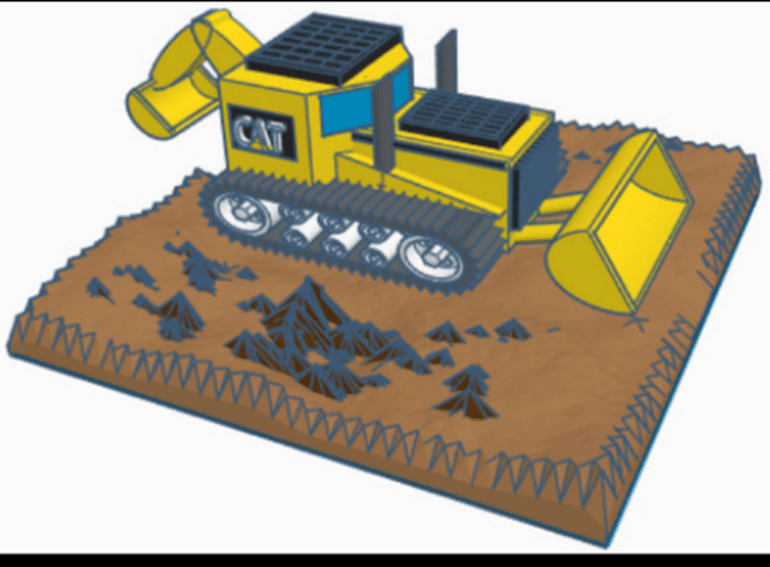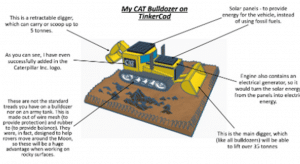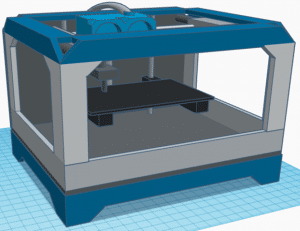
Year 8 pupil Keon Robert has won an international 3D design challenge with his idea for a solar-powered bulldozer with special caterpillar tracks based on those used on Moon rovers.
 Judges in the Polar Cloud CAT Inc. Design Challenge congratulated him for combining creativity with practicality in his design, and he also won appreciation from other users of American manufacturer Polar 3D’s Polar Cloud online 3D design platform.
Judges in the Polar Cloud CAT Inc. Design Challenge congratulated him for combining creativity with practicality in his design, and he also won appreciation from other users of American manufacturer Polar 3D’s Polar Cloud online 3D design platform.
To maximise his chances in the competition, which was sponsored by heavy plant manufacturer Caterpillar, Keon even produced an alternative design for the other type of caterpillar – the larval-stage insect – in its natural setting, as well as later producing a design based on snowflakes.
Keon’s victory in the heavy machinery category of the competition won a Polar Cloud-enabled Polar 3D printer and $100 for Queen Elizabeth’s School.
QE Head of Technology Michael Noonan said: “Keon’s achievement is a truly remarkable one. He promoted and shared his idea widely, and his was an outstanding example of design and creativity. He received plaudits from Polar 3D’s CEO, Gregory Lalonde, and many others within the Polar Cloud platform, one which has over half a million members.”
Keon explained his thinking and the process by which he arrived at the bulldozer design.
“I decided to reimagine and reengineer your typical bulldozer by adding features which allow for greater accessibility to remote areas, as well as providing a greener alternative to the standard vehicles.
 “Firstly, at the back, there is a retractable claw which is able to lift five tonnes. This was created as a feature to utilise when carrying more rubble or dirt. The treads for the vehicle are intended to be made out of wire mesh and rubber to ensure balance and protection, which is a necessity for users who require some means of transportation in more secluded regions.”
“Firstly, at the back, there is a retractable claw which is able to lift five tonnes. This was created as a feature to utilise when carrying more rubble or dirt. The treads for the vehicle are intended to be made out of wire mesh and rubber to ensure balance and protection, which is a necessity for users who require some means of transportation in more secluded regions.”
This combination of materials was, in fact, used by the vehicles taken on the Moon landing missions, and is, therefore, ideally suited to rocky environments, Keon explained in his design notes.
“Furthermore, photovoltaic cells were added in order to absorb the sun’s solar energy. This would then be converted to electrical energy to power the vehicle via a generator in the engine compartment. The engine compartment also includes lithium-ion batteries, as another energy source in the event of a breakdown.
“Finally, like any other bulldozer, there is another digger at the front, which can carry lift around 35 tonnes.”
 Judges stipulated that entries should not only fulfil criteria such as printability, design execution and creativity, but also prioritised those, such as Keon’s, which garnered higher numbers of ‘likes’ on the online platform.
Judges stipulated that entries should not only fulfil criteria such as printability, design execution and creativity, but also prioritised those, such as Keon’s, which garnered higher numbers of ‘likes’ on the online platform.
Keon entered the competition as a way of improving his CAD (Computer-Aided Design) skills and of engaging in the Polar Cloud platform – “essentially a workplace for engineers and designers to post and share their work…a STEM-oriented ‘Facebook’.
“I was frankly stunned when I found out I won the competition: the effort I had given it was extraordinary, so I felt it was definitely worth my time,” said Keon.
He added that he had surprised himself with the level of dedication he had brought to the competition, but feels that this will benefit him in the future, not least in terms of his schoolwork.
